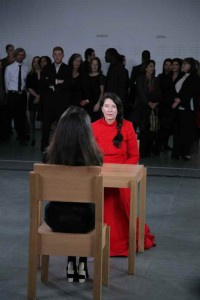« Reviews
Marina Abramović: The Artist is Present

Installation view of Marina Abramovi?’s performance The Artist Is Present at The Museum of Modern Art, 2010. Photo by Scott Rudd.© 2010 Marina Abramovi?. Courtesy the artist and Sean Kelly Gallery/Artists Rights Society (ARS), New York
Museum of Modern Art - New York
Curated by Klaus Biesenbach
How to keep performances alive?
The big problem with performance is that it only makes sense live.
-Marina Abramovi?.1
By Ernesto Menéndez-Conde
The Yugoslavian artist Marina Abramovi?’s retrospective “The Artist is Present” at MoMA gathers almost fifty works, and includes a live performance by Abramovi? and five re-performances by a group of young artists.
One of the achievements of the show is the sound: the simultaneous screening of several videos produces a mesmerizing effect, made with repetitions of words, shouts, music, and noises. Through sound, the videos, documents, and installations have the appearance of a choral work, which emphasizes the psychological or existential dimension of the artistic experiences. The polyphony stresses the anguish which is involved in the quest for freedom, physical contact, communication, self-identity or love related to Abramovic’s artistic practices.
The Artist is Present, Abramovi?’s live performance on the first floor, is a variation of her series of 22 performances, entitled Nightsea Crossing, done in collaboration with the German artist Ulay from 1981 until 1987. There are some differences between Nightsea Crossing and the MoMA performance. Instead of staring at her partner’s eyes, Abramovi? faces an unknown visitor, who makes a line in order to take a seat in front of her. She plans to repeat the performance for three months. Regardless of these distinctions, The Artist is Present could be seen as a re-performance, which follows the same principle of the other five that are re-enacted on the sixth floor.
How to keep the performance alive– this is one of the problems posited in Abramovi?’s retrospective. She already explored re-performances at the Guggenheim Museum in November 2005, when she dedicated a week to re-enacting seven works she considered influential in her career. In an interview with the Peruvian journalist Fietta Jarque, Abramovic said, “In order for a performance to remain alive, it has to be performed again.”2
This is an arguable statement. One of the conflicts related to performance art is its unique and ephemeral character, which would probably be preferable to preserve as a historical document, in the form of videos, photographs, or written statements (as it has been done for more than five decades, in what can now be seen as conventional ways of recording them). In the revivals– at least in the form that Abramovi? is conceiving them– the core of the performance is missed: the sense of protest, therapy or transgression is turned into a mere homage, or a parody. The artistic experiment becomes a consecrated, institutional artwork, which already had a place in art history.
This is what happens with Imponderabilia, which was done for the first time in June 1977 at the Galleria d’Arte Moderna di Bologna. It was a provocative performance, which triggered viewer’s sexual prejudices, and fears. Abramovi? and Ulay flanked the entrance of the gallery, naked. In order to access to the gallery, viewers had to squeeze their bodies against the artists, forced into a simultaneous sexual friction with both a man and a woman. The re-enactment at the MoMA seems rather a mockery. Instead of being at the entrance of the sixth floor, two young artists (or models) stand in a corner inside the show, as one among many other artworks. Using that path is no more than a choice, which is actually easy to avoid, since there is another wider access to the rest of the show. There is not novelty, and the provocation is turned playful remembrance.
On the stage, plays can be endlessly performed. Hamlet can be played numberless times, by different actors and companies. I am afraid this is not the case of artistic performances. Rather than a mise-en-scène of a play, to re-enact a performance seems like showing as an original painting what is a just replica of it.
(March 14 - May 31, 2010)
NOTES
1 Quoted by Cypriano, Fabiano. “Contemporary dance in Brazil and the world Patrocínio: Petrobras Texts Performance and reenactment: analyzing Marina Abramovi?’s Seven Easy Pieces”. 2 September 2009. <http://idanca.net/lang/en-us/2009/09/02/performance-e-reencenacao-uma-analise-de-seven-eeasy-pieces-de-marina-abramovic/12156>.
2 See, Jarque, Fietta. “Arte. ENTREVISTA con Marina Abramovi?: ‘Me interesa el aspecto espiritual del sexo’”.
3 February 2007. <http://www.eutsi.org/kea/cultura/arte-entrevista-con-marina-abramovic-qme-interesa-el-aspecto-espiritual-del-sexoq.html>.
Ernesto Menéndez-Conde is an art critic based in New York. He has published in magazines in New York, Spain, Havana, and Miami.
Filed Under: Reviews


































